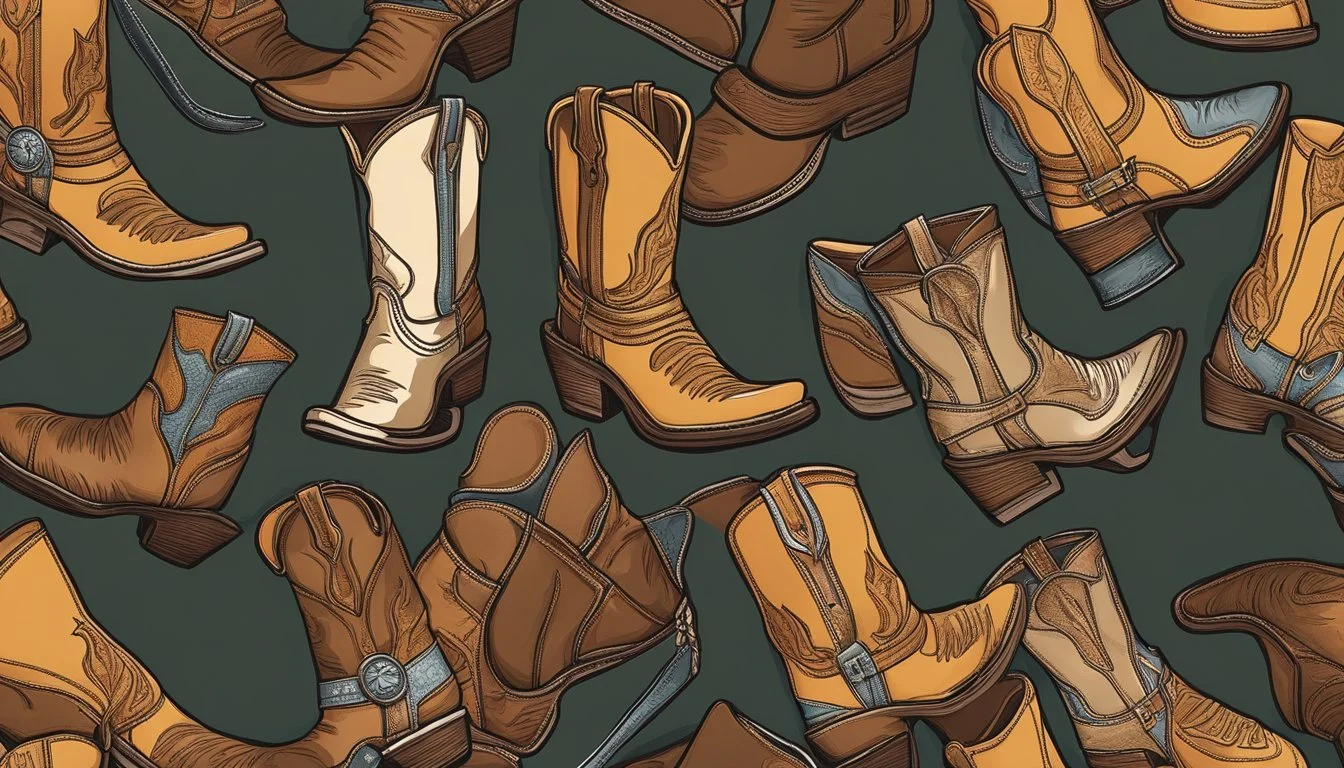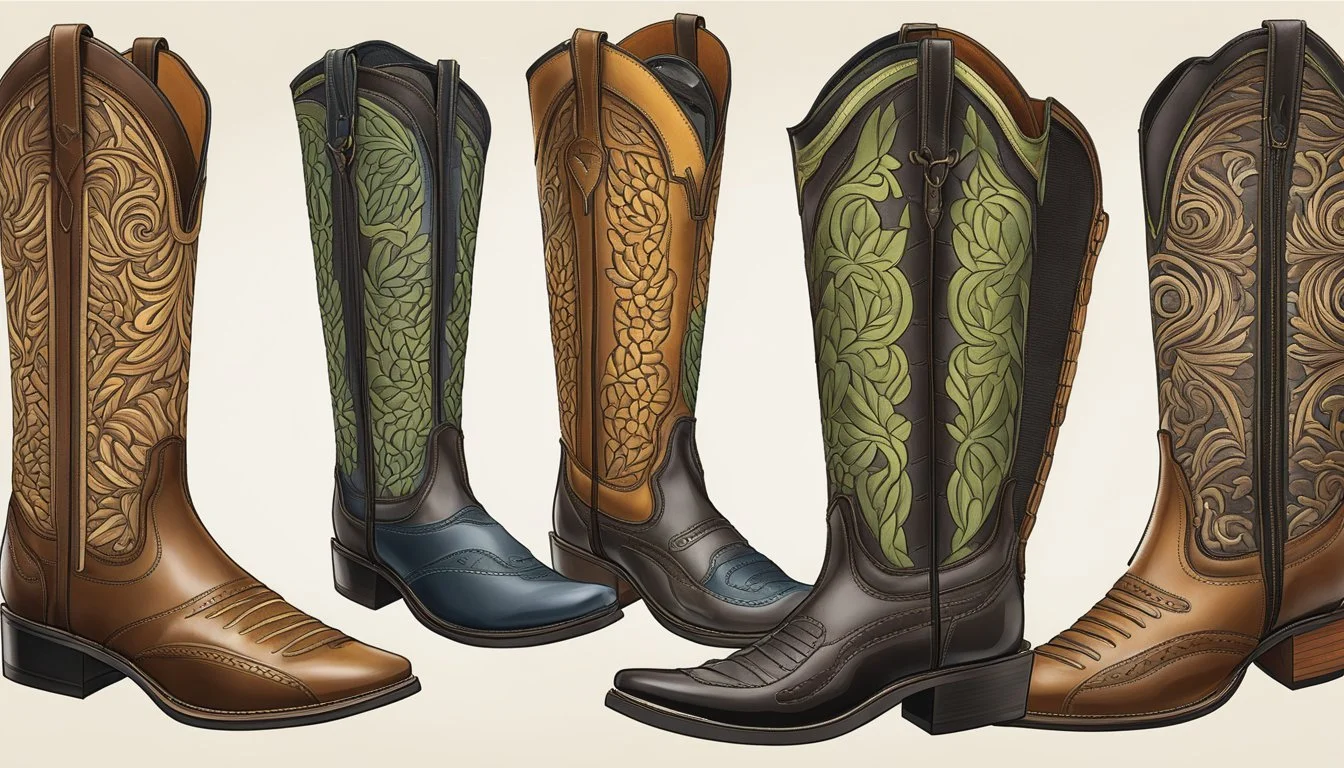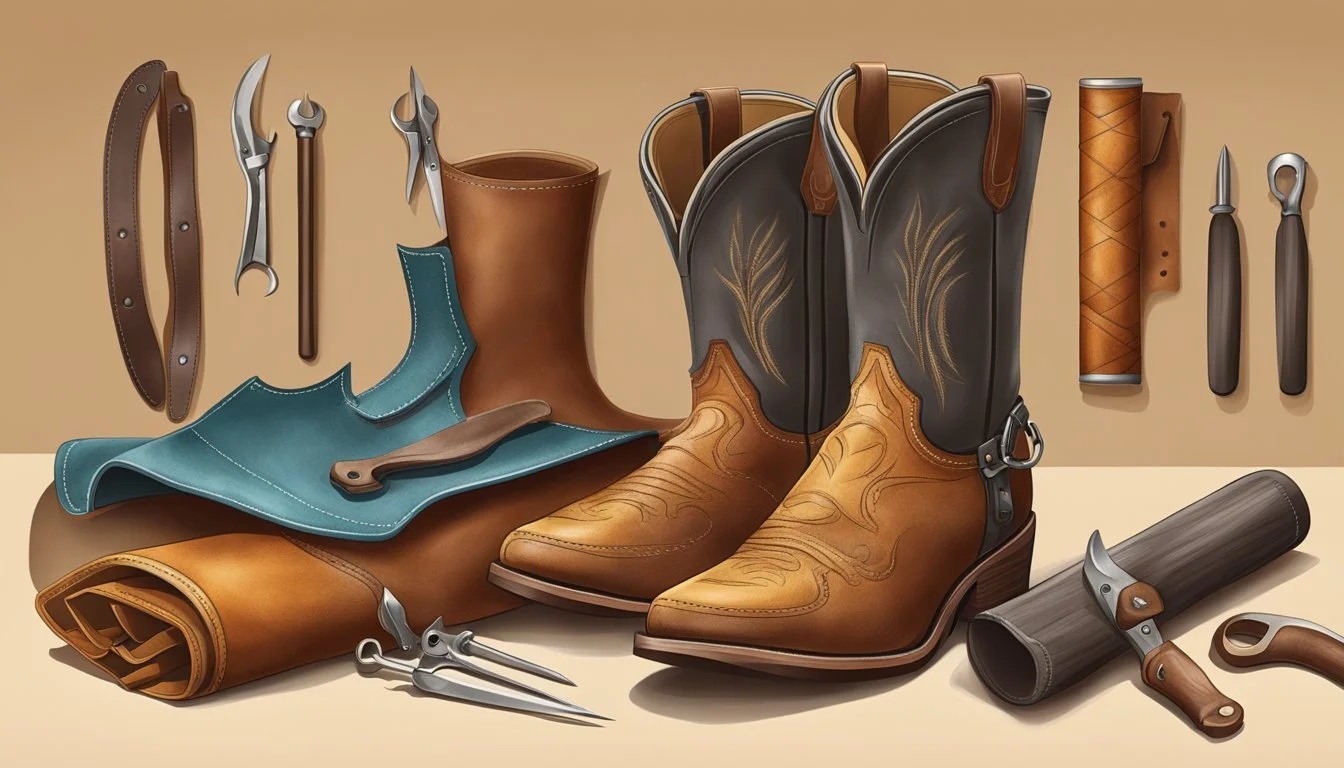The Process of Making Cowboy Boots
A Step-by-Step Journey to Sartorial Elegance
Cowboy boots, a symbol of the rugged American West, have transitioned from functional footwear to high fashion items gracing runways and city streets. Their distinctive design, featuring a high heel and pointed toe, originates from the practical needs of horse riders. Throughout their history, cowboy boots were designed to protect and assist cowboys in the saddle, the narrow toes allowing for quick insertion into stirrups and the high, sloped heels preventing the foot from sliding through.
Fashion trends have propelled these boots beyond their utilitarian origin, making them popular across diverse demographics. Nowadays, cowboy boots are crafted not just for durability but also for style, reflecting the wearer's personality through a vast array of materials, patterns, and decorations. Despite the evolution of these boots into fashion statements, the art of making cowboy boots remains steeped in tradition, involving meticulous handcrafting techniques to provide the perfect balance of fit, form, and function.
The history of cowboy boots is interwoven with the story of American expansion and culture. What began as essential gear for cowboys driving cattle across the plains has been adapted over the years, with modifications made to enhance comfort and versatility. Yet the essence of the cowboy boot design still honours its roots, encapsulating the spirit of the Old West while continuing to evoke a sense of adventure and individualism in modern fashion.
The History of Cowboy Boots
The cowboy boot has evolved from practical riding gear to a fashion statement, having its roots in the 19th century designs of Mexican vaqueros. Its journey is marked by iconic makers and evolving styles that reflect the cultural shifts in Western wear.
Evolution from Vaquero to Modern Style
The early cowboy boots were shaped by the needs of Mexican vaqueros, who were skilled horsemen. They required boots that were durable, comfortable for long rides, and equipped with a high heel to secure their feet in the stirrups. By the mid-19th century, as cattle-driving cowboys became central to the American West, the demand for a more specialized boot gave rise to what would be recognized as the cowboy boot.
Distinct contributions to the cowboy boot design included high shafts, which protected legs from thorns and snakes, and pointed toes that made it easier to slide into stirrups. Early boots were simplistic, made from cowhide, and focused on functionality. However, as the cowboy boot entered the 20th century, it began to transition into a symbol of style as much as utility, and bootmakers started to introduce intricate stitching and quality craftsmanship.
Influence of 19th Century Design on Today's Fashion
The influence of 19th-century cowboy boot designs is still prevalent in today's fashion. The historic significance of makers such as Tony Lama and Justin Industries can't be overstated; their boots merged practical construction with the allure of Western mystique.
The structure and durability of the boots have remained constant—leaning on the tried-and-true methods of the 19th century—while contemporary fashion has embraced the cowboy boot as a versatile element of modern style. Materials have expanded beyond traditional cowhide to include exotic leathers and environmentally friendly synthetics, but the iconic silhouette continues to pay homage to the craftsmanship of early bootmakers.
Today, cowboy boots are not just for ranch work but are also fashioned for the dance floor, reflecting their transition from pure Western wear to universal fashion pieces.
Understanding Boot Materials
When crafting cowboy boots, selecting the appropriate material is crucial for both aesthetics and functionality. The choice of leather or alternative materials can significantly affect the boot's durability, comfort, and style.
Leather Varieties and Selection
Cowhide: This is the most commonly used leather due to its durability and ease of access. Cowhide is resistant to wear and tough against elements, making it a suitable material for everyday work boots.
Alligator and Snake: Exotic leathers such as alligator and snake skin offer unique patterns and high-end appeal. They are often found in fashion-oriented cowboy boots and require specific care to maintain their distinctive textures.
Ostrich: Recognized for its softness and comfort, ostrich (What wine goes well with ostrich?) leather provides a distinctive look with its quill patterns. Its flexibility makes it a favored material for premium, luxury cowboy boots.
Kangaroo Skin: Light yet strong, kangaroo leather is known for its tensile strength, which can offer the same durability as cowhide but with less bulk and weight.
Horsehide and Pigskin: Less common than cowhide, horsehide offers a smooth, tough surface, while pigskin, with its porous nature, can provide a distinct texture and is quite breathable.
When selecting leather, bootmakers consider not only the raw materials but also the tanning process, which can influence the leather's color, texture, and overall finish.
Alternative Materials and Their Usage
Synthetics and Non-Leather Alternatives:
Vegan Leather: Made from plastics or plant materials, vegan leather offers an ethical alternative without the use of animal products. It is less durable but preferred for its lower impact on wildlife.
Rubber and Plastics: For more industrial or specialized needs, rubber soles or plastic reinforcements can be employed. These materials provide additional waterproofing and resistance to harsh chemicals.
Fabric Inclusions:
Accents such as canvas or suede can be integrated for aesthetic diversity or for specific functional attributes, such as breathability.
Hybrids:
Combining different materials like leather with textile inlays allows for customized features, such as flexibility in certain areas while maintaining overall boot integrity.
Bootmakers carefully choose materials based on the intended use, aesthetic preference, and environmental conditions that the cowboy boots will face. The incorporation of alternative materials is becoming more prevalent as consumers seek options that suit individual needs and ethical considerations.
Pre-Production Process
The pre-production phase in making cowboy boots is where meticulous planning meets material selection to lay the groundwork for the entire boot-making process.
Creating the Design and Pattern
Bootmakers begin by crafting detailed designs that will dictate the aesthetics and functional characteristics of the cowboy boots. Patterns are then meticulously drawn based on these designs which serve as the essential template for cutting the leather. The pattern-making step ensures the boots will have the correct form for both style and wearer comfort.
Preparing the Hide and Leather Cutting
Selecting the best quality hide is paramount, as it forms the foundation of the boots. The hides, primarily sourced from cattle, undergo a preparation process that includes cleaning, drying, and treating to become workable leather. The cutting process is executed with precision, following the patterns developed earlier. Precision in cutting is key to how pieces will align during assembly.
Constructing the Cowboy Boot
The construction of a cowboy boot is an intricate process involving the assembly of various leather parts to create a durable and stylish piece of footwear. Precision and attention to detail ensure the boot is functional for riding while being increasingly considered a high fashion item.
Assembling Uppers and Vamp
The upper part of a cowboy boot includes the part of the boot that wraps around the foot above the sole, often embellished with decorative stitching or patterns. Craftsmen carefully select and cut the leather, shaping it to form the vamp, which covers the front and bottom of the foot, and the counter, supporting the heel. Pieces are then stitched together, with the vamp skilfully attached to the upper to create the main structure of the boot.
Attaching the Sole and Heel
Once the upper is assembled, the next step is the construction of the sole and heel. A metal shank is placed for arch support, followed by a leather insole that is tightly fitted into the boot. The outer sole is carved to align with the insole and affixed, often involving welting for stronger joins. Heels, typically made of stacked leather, are then nailed and glued into place for stability and height.
Final Steps to Completion
Finishing touches on cowboy boots are critical for aesthetics and longevity. All remaining nails are removed and the boots are cleaned and conditioned. Polishing and burnishing the leather gives the boots their distinctive sheen. Finally, the boots undergo a thorough inspection to ensure they meet quality standards before being deemed complete.
Key Features of Cowboy Boots
Cowboy boots have a distinct design and construction that set them apart from other footwear. They are crafted to meet both functional and fashionable needs, with each part playing a crucial role.
Identifying Unique Boot Parts
Upper: The upper part of cowboy boots extends from the sole to the top of the boot, traditionally reaching halfway up the shin. It's often crafted from various leather types and can include elaborate stitching and patterns.
Toe: Cowboy boots feature a pointed toe shape that varies from a classic round to a sharp square or snip toe. This design helps in sliding into stirrups with ease.
Heel: The heel of a cowboy boot is distinctive; it's usually higher than that of regular boots and slopes under the foot, providing stability while riding.
Counter: This area of the boot adds support to the heel and is situated at the back of the boot, often reinforced to maintain boot shape.
Heel Cap: Beneath the counter, the heel cap adds another layer of support and sometimes showcases decorative elements.
Lining: Inside the boot, the lining is crucial for comfort and can be made of soft leather or other materials to prevent blisters and provide insulation.
Understanding the Importance of the Last
The last is a form used during the construction of the boot, representing the anatomical shape of the foot. This form determines the fit and comfort level of the final product.
It holds the material in shape while the boot is crafted, especially when attaching the sole and during the complex assembly process—ensuring the stitching, cutting, and shaping are precisely executed to standard specifications.
Elements of Style and Function
Crafting cowboy boots involves a harmonious blend of aesthetic designs and tailored comfort ensuring both style and functionality coexist seamlessly. Each boot reflects a polished look with artfully stitched decoration while maintaining the comfort essential for various activities, from line dancing to outdoor work.
Decorations and Stitch Patterns
Cowboy boots are often adorned with intricate decorations that give each pair a distinctive look. These embellishments range from simple stitching patterns to detailed designs incorporating elements of nature, symbols, or complex geometrical shapes. High-quality boots feature:
Stitched Decoration: Utilizing strong threads, boots are often decorated with patterns on the shaft, vamp, and heel counter.
Visual Appeal: Decoration on cowboy boots is not only for looks but also can reveal much about the wearer's personal style.
Popular stitch patterns include classic motifs like eagles, stars, horseshoes, and other thematic elements specific to western culture.
Balancing Comfort with Fashion
While cowboy boots are a statement of fashion, achieving a balance with comfort is paramount for bootmakers. Comfort features designed into cowboy boots include:
Shaped to Fit: The boot's insole and outsole are crafted to conform to the wearer's foot, reducing strain and providing support.
High-Quality Materials: Leather is commonly used for its durability and ability to mold to the foot, while rubber and synthetic materials offer flexibility.
A metal shank is often added to fortify a high arch for additional support. A well-designed cowboy boot melds style, including the height and shape of the heel, with practicality, resulting in a footwear that's both comfortable and fashionable.
The Finishing Touches
In the final stage of cowboy boot creation, meticulous attention to detail ensures each pair meets aesthetic and quality standards. The process involves both polishing for visual appeal and rigorous inspections for any needed corrections.
Polishing and Finishing for Aesthetics
Once a cowboy boot has gone through the main stages of assembly, it transitions to the act of finishing for aesthetic enhancement. At this point, the boot undergoes its transformation with several key steps:
Dyeing: If the design calls for it, dyes are carefully applied to the leather to achieve the desired color. Consistency is crucial to avoid blotches or uneven tones.
Waxing and Polishing: A combination of waxing and polishing gives the cowboy boot its distinctive sheen. They use specific compounds and techniques to enhance the natural beauty of the leather and create a high-quality finish.
A craftsman will typically use a soft cloth or brush to evenly apply these substances, buffing the boot's surface to a fine shine. Beyond visual allure, these finishing touches serve as a protective layer, safeguarding the leather from moisture and environmental wear.
Quality Checks and Corrections
The final step before a cowboy boot can be deemed ready for the showroom involves a series of quality checks to identify and rectify any defects:
Inspection for Imperfections: They inspect the boots for any flaws in craftsmanship, such as misaligned seams or loose threads. Even the smallest imperfection warrants correction to ensure the final product upholds the brand's standard of quality.
Welt and Sole Examination: The welt (the strip of leather stitched to the upper and insole of the boot) is checked for secure attachment, and the sole is inspected for proper alignment and adherence.
Structural Adjustments: If any part of the boot does not conform to the intended shape or fit, the last, or form, is reinserted to make fine adjustments. Glue and other fastening substances may be reapplied to achieve structural integrity and comfort.
They handle each boot with great care, ensuring that the finished pair not only looks exceptional but will also endure the test of time and wear.
Cowboy Boots in Popular Culture
Cowboy boots transcend mere footwear, emerging as enduring icons in both Western culture and modern fashion landscapes. They represent tradition and popular aesthetic, all while adapting to contemporary trends and celebrity styles.
Boots as Symbol of Western Life
These boots began as practical workwear for cowboys, encapsulating Western life and hardworking spirit. Their distinctive design provided necessary functionality for riding and ranch work. Today, cowboy boots still carry that symbolism of tradition and are viewed as an authentic embodiment of the American West.
Contemporary Fashion and Celebrity Influence
Cowboy boots have galloped beyond the ranch, landing on urban pavements and high fashion runways. Their versatility and durability make them appealing for modern fashion enthusiasts. Roper boots, a variant with a shorter shaft and a more rounded toe, have found favor for their comfort and subtler Western feel. Fashion designers often elevate cowboy boots into luxury items, and celebrities don these boots, signaling their lasting popularity and influence in mainstream fashion.
The Artistry of Bootmaking
The process of crafting cowboy boots is a unique amalgamation of time-honored techniques and modern innovations. Master artisans ensure each pair of boots is a testament to exceptional craftsmanship and contemporary style.
Craftsmanship and Customization
Crafting a pair of cowboy boots demands a high degree of skill and precision. Artisans start by carefully selecting materials; then they cut and shape the leather to form the boot's upper, vamp, and counters. Intricate stitching and hand-tooled designs showcase the artisan's creativity and attention to detail.
Customization is at the heart of cowboy boot artistry. Customers often have the option to select materials, colors, and designs that reflect their personal style. Custom-fitted boots are meticulously crafted to match the individual's foot, providing both comfort and a statement of personal expression.
Innovations and Modern Techniques
While tradition forms the foundation of bootmaking, the integration of modern technology has enhanced the manufacturing process. Artisans use computerized sewing machines to execute complex patterns with precision that would be difficult to achieve by hand. Laser cutting and 3D printing technologies have also been introduced, allowing for more intricate designs and a better fit.
Despite technological progress, the role of the artisan remains irreplaceable in the process. Their expertise ensures that modern methods harmonize with traditional craftsmanship to produce boots of outstanding quality and durability.






